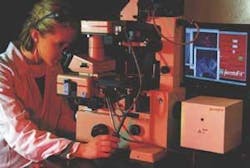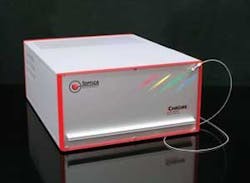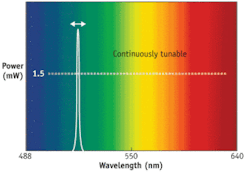BIOPHOTONICS INNOVATION: Ultrafast pulse delivery, laser tunability products win honors at CLEO
“From imaging cells and viruses in extraordinary detail to carrying out flow cytometry on the blood vessels of living creatures to the removal of melanomas from human patients, [ultrafast laser] technology is proving its value in the entire arena of life science and biomedicine,” wrote Peter Gwynne in a report on femtosecond lasers in the May/June 2009 issue of BioOptics World. But despite recent technological advances, there is a roadblock of the fulfillment of ultrafast lasers’ potential, according to BioPhotonic Solutions (BSI; Okemos, MI): delivering the ultrashort pulses to the target. The broad bandwidth of ultrashort pulses is prone to high-order dispersion introduced by coatings that cannot handle a spectral bandwidth broader than 100 nm, and by high-numerical aperture microscope objectives that can turn a 10 fs pulse into a 1 ps pulse. Manual optimization of the laser in most cases requires an expert to adjust the system.
For those reasons, BSI’s femtoFit, a commercial pulse-shaping system based on second-generation multiphoton intrapulse interference phase scan (MIIPS) technology stole the show at this year’s Conference on Lasers and Electro-Optics and International Quantum Electronics Conference (CLEO/IQEC) and associated PhotonExpo. The product began by capturing the attention of the 2009 PhAST/Laser Focus World Innovation Award judges and winning the prize. FemtoFit replaces two instruments (pulse characterization and pulse shaping) with one, and turns in much better performance than can be achieved by an expert using separately specialized equipment.
FemtoFit occupies one-tenth the volume of the previous technology and operates at twice the speed during automated pulse characterization. And because of the new optical design and components used, the system can be sold for approximately one-third of the price of its competitors and previous systems. The impact of all this is easy accessibility for a wide range of users–which for the first time can include laser manufacturers and manufacturers of instruments that depend on ultrafast lasers, such as two-photon microscopes. FemtoFit requires just seconds to measure high-order dispersion at the desired target (for example the focal plane of a two-photon microscope) and eliminate it with the liquid-crystal pulse shaper.
“Just as electronic fuel injection eliminated the need for motor tune-up in automobiles, femtoFit eliminates the need of a Ph.D. to optimize a femtosecond laser,” BSI said in its award application.
The system is compatible with all commercial femtosecond lasers with wavelengths ranging from the visible to the infrared. Marcos Dantus, BioPhotonic Solutions’ president and CEO, described the product’s introduction as a “tipping point” for MIIPS technology: the size, price (it is approximately one-third the price of the Silhouette system with MIIPS sold by Coherent under license from BPI) and performance (faster and more accurate pulse precompression) will allow integration into OEM systems for corrective eye surgery, dentistry, and sensing of chemical or biological warfare agents, for instance.
Honorable mention: tunable visible laser
BioPhotonic Solutions, which has the exclusive license to the MIIPS technology, accepted the award at the CLEO plenary session, which also recognized four “honorable mention” products. Among these was Toptica Photonics’ iChrome Ultra-Wide Tunable Visible Laser for Biophotonic Application and Optical Metrology. According to judges with the Photonic Applications, Systems and Technologies (PhAST) Conference and Laser Focus World magazine, iChrome is “a user-friendly, widely tunable visible fiber laser for fluorophore excitation and other applications in microscopy and spectroscopy.”
The value proposition for iChrome lies in the fact that many applications–such as fluorescence and confocal microscopy, flow cytometry, and screening techniques in drug discovery–require different laser light sources for excitation of specific fluorophores. If lifetime imaging data are of interest too, several more pulsed laser sources are required, each having one or sometimes very few spectral lines and its own power supply, housing, cooling requirements and beam characteristics. Noise performance and beam quality are optimized for the applications today, but integration and spatial superposition is always a hassle for the manufacturer–not to mention aftermarket integrators or end users. Moreover, existing sources are not tunable over a significant wavelength, so when a researcher wants to move to a slightly different wavelength (or optimize excitation efficiency, reduce cross talk or bleaching, for instance) he or she must switch to a different source.
The fiber-laser-based iChrome, by contrast, can automatically set the laser output to any wavelength in the visible spectrum, from 488 to 640 nm (see Fig. 2). Unlike conventional white-light sources, it does not filter narrow-bandwidth laser pulses from an intrinsically noisy supercontinuum. Even the coherence of the fundamental laser is preserved during the frequency generation processes.The PhAST/Laser Focus World Innovation Awards Program honors the most timely, ground-breaking products in the field of laser science. Entries are evaluated on criteria critical to product success: impact, functionality, life expectancy, effect on the optics industry, innovation, and patents or trademarks. For more information, visit the awards web page, phastconference.org/innovation.
About the Author

Barbara Gefvert
Editor-in-Chief, BioOptics World (2008-2020)
Barbara G. Gefvert has been a science and technology editor and writer since 1987, and served as editor in chief on multiple publications, including Sensors magazine for nearly a decade.


